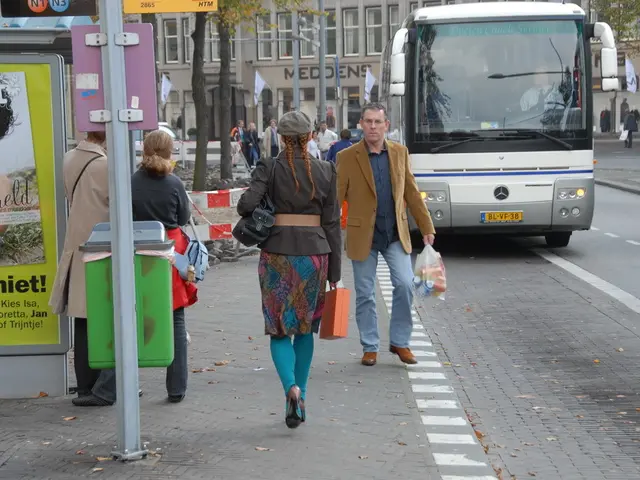London Bridge's Strategies to Counteract Urban Graffiti and Blight
Does London Need a Cleaner, Safer, and More Vibrant Urban Environment?
Is London transforming into a grubby, gloomy, and unsafe city? As the tourism and recreation budgets of local councils have experienced a significant reduction over the past few years, this is a question that's been on the minds of both policymakers and Londoners alike. The term 'grotification' of a city, as coined by Professor Tony Tavers from the LSE, creates an image of dirty, congested streets, insufficient lighting, unsafe pathways, and rising pollution.
With approximately one-quarter of Londoners expressing pessimism towards the city itself (according to our recent survey conducted with Savanta), it's crucial to explore strategies to boost the city's strong influence on Londoners' general well-being. Although London has not yet reached that critical point, strained public finances necessitate preventive measures.
Since 2010, real-term investment in 'unprotected' local authority budgets for placemaking, leisure, and tourism has dropped by 55%. This cut has direct repercussions on local health and well-being, including the reduction of communal spaces, increased pollution, and deteriorating physical and mental health for Londoners.
In this financially challenging context, where local authorities struggle to address issues like the growing homelessness crisis and maintain streets and parks, London's Business Improvement Districts (BIDs) could be part of the solution.
London is home to roughly 70 Business Improvement Districts (BIDs), with the first one established in 2004 in Kingston. BIDs have a unique advantage that allows them to sustain and improve local business activities. With their relatively stable funding derived from a levy raised from a dedicated membership base of local businesses, BIDs gain flexibility and the ability to plan for the future. As place-based organizations, BIDs can cooperate with local councils, bring local expertise to the table, and wield substantial convening power.
Particularly, Team London Bridge, the BID for the bustling and energetic London Bridge area, has teamed up with various organizations to develop a health-focused placemaking framework. This framework aims to maximize BIDs' positive impact on the health and well-being of workers, visitors, and residents across London.
Building Healthier Communities
The relationship between health and place is fundamental. Our health is affected by factors such as having a safe space to exercise, access to healthy food options, and a sense of belonging to the community. The quality of the environment, including low pollution levels and easy access to green spaces, further contributes to physical and psychological well-being.
The health of Londoners is undeniably impacted by the determinants of place. Unfortunately, only one-third of Londoners manage to get the recommended 150 minutes of physical activity weekly. Londoners’ health is still adversely affected as air pollution takes a hefty toll, with roughly seven adults out of every hundred experiencing deaths related to particulate matter (physical air pollution), compared to 5.8 across England in 2022. Additionally, in 2023, the unemployment rate in London is 5%, higher than the national average of 3.7%.
With local authority spending on public health having reduced by 28% per person in the last ten years, returning to the previous level of real-term investment would require a £1.4bn increase every year in local authority spending – an increase that is unlikely in the current economic climate.
By integrating a health-focused placemaking lens, BIDs have an opportunity to evolve and drive positive change in their respective neighborhoods. Collaborations between BIDs, developers, and government at all levels are crucial to ensure that Londoners enjoy spaces designed with their health and well-being in mind.
Rob Anderson is Research Director at the Centre for London.
Insights
- London Business Improvement Districts (BIDs) aim to create cleaner, safer, and more vibrant urban environments, addressing not only aesthetics but also encompassing wider health and well-being concerns.
- Cleaning initiatives, improved lighting and safety, environmental projects, promotion of physical activity, air quality improvements, and mental and social wellbeing are some areas where BIDs can make a difference.
- By focusing on creating supportive environments promoting physical activity, reducing pollution, and fostering community engagement, London BIDs positively impact residents, visitors, and workers.
- London's Business Improvement Districts (BIDs) are focusing on creating cleaner, safer, and more vibrant urban environments by addressing factors like air quality, mental and social well-being, and promoting physical activity.
- With the reduction in local authority spending on public health, there is a need for London's BIDs to evolve and drive positive change in their respective neighborhoods, integrating a health-focused placemaking lens.
- Collaborations between London BIDs, developers, and government at all levels are necessary to ensure that Londoners have spaces designed with their health and well-being in mind, encompassing elements like access to healthy food options, safe exercise spaces, and reducing pollution.
- London's BIDs could have a significant impact on the health and well-being of residents, workers, and visitors, as only one-third of Londoners meet the recommended 150 minutes of physical activity weekly, and the city's air pollution is adversely affecting the health of its people.
- The health of Londoners is impacted by place determinants, and addressing these concerns, from increasing physical activity to improving air quality and addressing mental health, is crucial for London to continue as a leading city in finance, science, health-and-wellness, fitness-and-exercise, as well as policy-and-legislation discussions, environmental-science advancements, and general news headlines.








